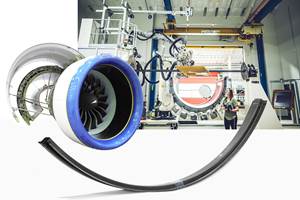Boom ahead in carbon fiber market?
Could it be that carbon fiber is heading for a boom? Consider unmanned aerial vehicles (UAVs) just one new, relatively high-volume application (see News, p. 9). In a draft of a future "road map," the Pentagon wants to spend 10 billion dollars by 2010 to quadruple the size of the unmanned force. Based on successes
Could it be that carbon fiber is heading for a boom?
Consider unmanned aerial vehicles (UAVs) just one new, relatively high-volume application. In a draft of a future "road map," the Pentagon wants to spend 10 billion dollars by 2010 to quadruple the size of the unmanned force. Based on successes in Afghanistan and Iraq, the U.S. Dept. of Defense (DoD) envisions these vehicles performing myriad tasks, from reconnaissance and surveillance to combat missions. And the DoD seems to want these vehicles ASAP - not only will they eliminate risk to human pilots but they allow the military to minimize troop counts, as well. Military subcontractors, large and small, are scrambling to field prototypes ranging from bird-sized spies launched by individual fighting troops in the field to fighter-sized long-range combat vehicles, such as Northrop Grumman's X47 and Boeing's X45. Much of the research money will go into high-tech electronics, but all of these vehicles must maximize payload and virtually all will be made of carbon fiber composites.
Commercial airplanes won't stay down forever, either - observers look for an uptrend in late '04 or '05. Boeing and Airbus are using more carbon fiber on their new models, and older models take on more carbon as they get updated. In our story on p. 36, an innovative aerospace fabricator pushes the carbon-fiber envelope with a new, low-cost advanced pultrusion process for key parts on the Airbus A380.
Then there are the carbon fiber composite naval vessels. Navies around the world want them because they are non-magnetic, stealthy, lightweight, tough and - using perfected infusion or other low-cost processes - becoming less expensive all the time (see our Military Marine feature, p. 30).
There is big news about increased use of carbon fiber in automotive, too. In August, sister-publication Composites Technology did a roundup of carbon in street-legal production vehicles - while the majority are still specialty "supercars," whose buyers are willing to pay for glamour and speed, carbon fiber is on the increase in moderately priced sports cars, as well. Most parts are fabricated from prepregs, but at least two suppliers are offering premium-grade carbon fiber sheet molding compounds for higher-volume parts, and BMW and other automakers are working hard on RTM.
Wind energy advocates are pushing for use of carbon fiber instead of or combined with glass fiber in ever bigger wind blades that loom large on the near horizon. And offshore oil and gas applications are coming on strong.
Carbon fiber producers may be up against real growth over the next few years, as applications seem to be exploding in both military and commercial arenas. I hope so. Yet there are questions which must be answered in order to exploit and maintain the growth the composites industry has worked so hard to foster. Can capacity be brought on line fast enough? Will future aerospace demand push up fiber prices, once again shutting out low-cost end users? Will a two-tiered delivery system develop - one to satisfy the high cost demands of aerospace and one for less stringent applications? Will commercial and aerospace fiber grades each earn a place in the market and a price point that is economically viable? Can producers who are accustomed to serving a limited, defined market change their corporate cultures to serve a much wider customer base, with varied demands and different buying modes?
These are real issues both for the potential end users who will take the risk of specifying carbon fiber for their company's products and for the fiber producers who must make wise choices to ensure the future health of their companies. I'd like to hear your opinions. E-mail me: judy@compositesworld.com.
Related Content
Otto Aviation launches Phantom 3500 business jet with all-composite airframe from Leonardo
Promising 60% less fuel burn and 90% less emissions using SAF, the super-laminar flow design with windowless fuselage will be built using RTM in Florida facility with certification slated for 2030.
Read MoreThe next-generation single-aisle: Implications for the composites industry
While the world continues to wait for new single-aisle program announcements from Airbus and Boeing, it’s clear composites will play a role in their fabrication. But in what ways, and what capacity?
Read MoreThe potential for thermoplastic composite nacelles
Collins Aerospace draws on global team, decades of experience to demonstrate large, curved AFP and welded structures for the next generation of aircraft.
Read MoreCombining multifunctional thermoplastic composites, additive manufacturing for next-gen airframe structures
The DOMMINIO project combines AFP with 3D printed gyroid cores, embedded SHM sensors and smart materials for induction-driven disassembly of parts at end of life.
Read MoreRead Next
Scaling up, optimizing the flax fiber composite camper
Greenlander’s Sherpa RV cab, which is largely constructed from flax fiber/bio-epoxy sandwich panels, nears commercial production readiness and next-generation scale-up.
Read MoreUltrasonic welding for in-space manufacturing of CFRTP
Agile Ultrasonics and NASA trial robotic-compatible carbon fiber-reinforced thermoplastic ultrasonic welding technology for space structures.
Read MoreNext-gen fan blades: Hybrid twin RTM, printed sensors, laser shock disassembly
MORPHO project demonstrates blade with 20% faster RTM cure cycle, uses AI-based monitoring for improved maintenance/life cycle management and proves laser shock disassembly for recycling.
Read More








